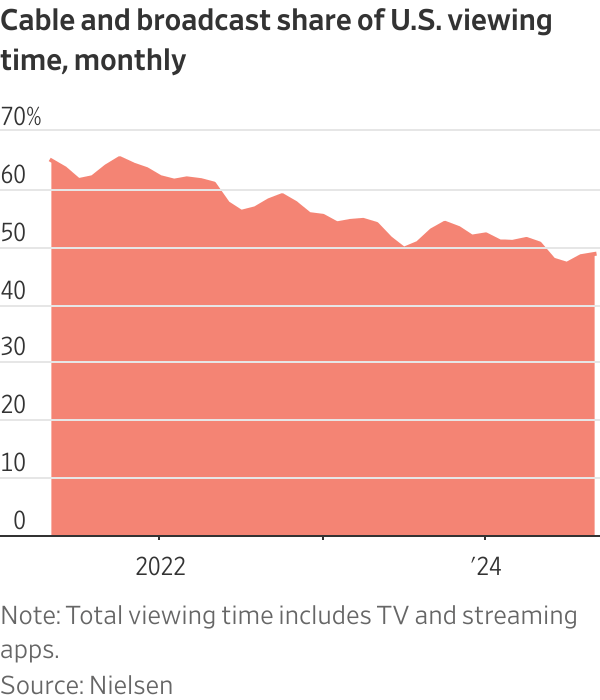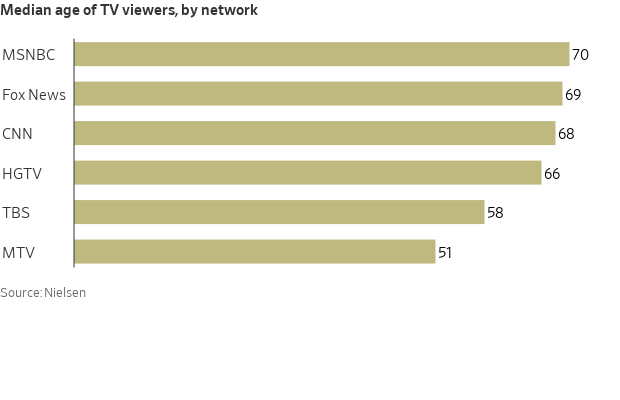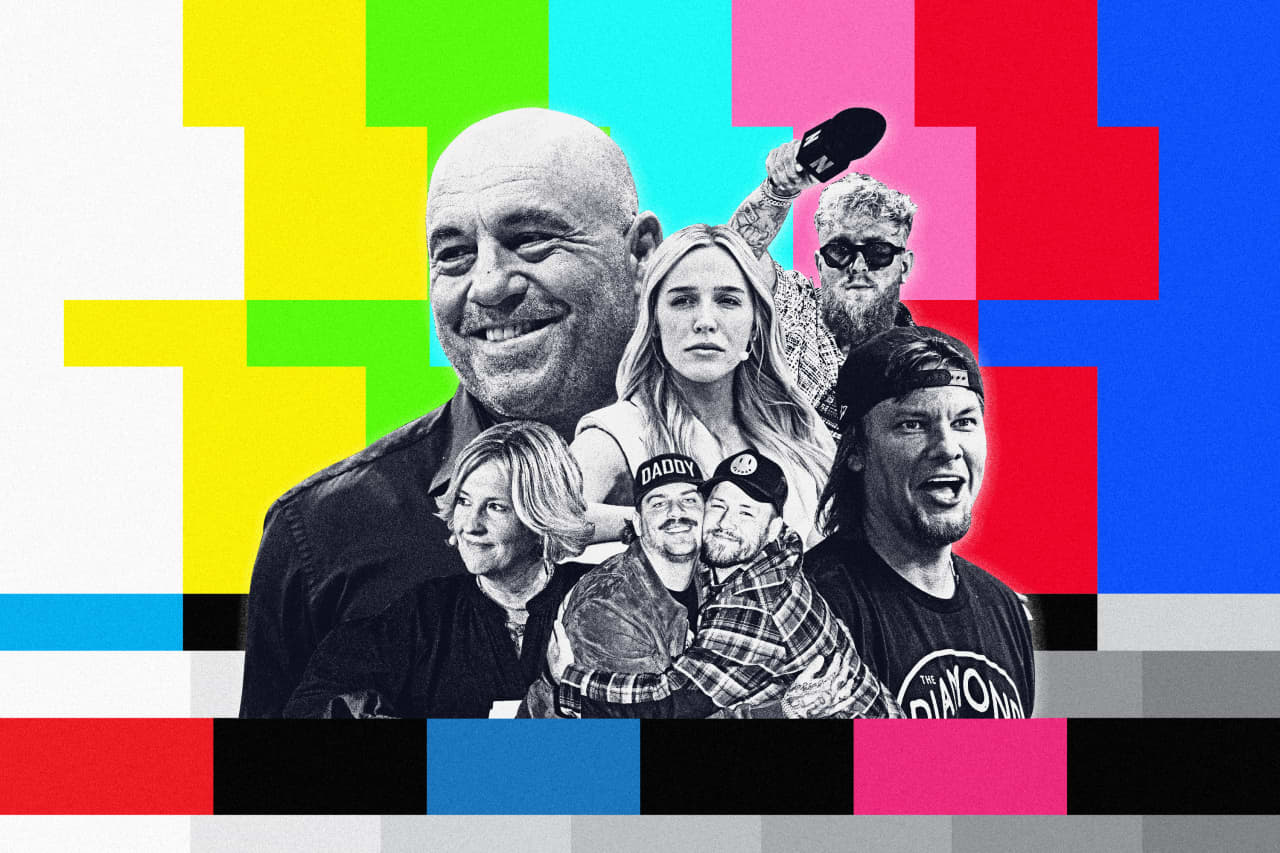Two weeks ago, Donald Trump sat down with the podcaster Joe Rogan for three hours, an episode that drew more than 45 million views on YouTube and over 25 million listens across Spotify and other platforms. On election night, Rogan was among several podcast hosts who got shout-outs in Trump’s victory celebration.
It underscored what the 2024 presidential race made clear: A new media landscape has emerged. The traditional gatekeepers of political discourse—TV networks and newspapers—are shrinking in influence as Americans turn to many more outlets for information.
The percentage of people listening to podcasts in a given month has more than tripled in a decade. In the social-media realm, more than half of TikTok’s users say they regularly get news on the platform, according to the Pew Research Center. Elon Musk ’s takeover of X has had a major impact, with political content, especially right-leaning posts , blanketing new users’ feeds.
TV news remains a massive draw for Americans in the biggest moments. But younger audiences have fled, and there were signs even on election night of an overall erosion in the medium. The main three cable channels were down 32% in viewership collectively compared with 2020, to around 21 million, with CNN losing almost half its audience.

The upshot: Americans are hearing very different narratives about current events from very different places. Many factors might have contributed to the election’s outcome , but the media world’s fracturing is hard to ignore.
“Our information landscape has splintered into more and more pieces. Large, institutional news organizations are a smaller part of the geography,” said Nancy Gibbs, a former editor in chief of Time who is director of Harvard’s Shorenstein Center on Media, Politics and Public Policy. “So voters were all watching different campaigns play out, with different messages and meaning and momentum.”
‘Real conversations’
Freewheeling online talk shows hosted by comedians, YouTubers and other celebrities are designed to entertain as much as to inform. They are competing for attention with mainstream media organizations that have a different mission and who are bound by editorial standards.
Some 47% of people in the U.S. have listened to a podcast in the past month, including nearly 60% of people who are under 35, according to Edison Research. And 54% of podcast listeners say getting news or political analysis is an important benefit of the medium, according to the industry advisory and data tracker Sounds Profitable.
Trump went on about 20 podcasts this year, including the comedian Theo Von’s show and Barstool Sports’ “Bussin’ With the Boys.” The interview with Rogan, who wound up endorsing Trump right before the election, was the culmination of a strategy to appeal to younger men. Trump got the support of 56% of male voters ages 18 to 29, according to the AP VoteCast survey of the electorate.
“The whole manosphere is listening to podcasts,” Marina Hyde from “The Rest Is Entertainment” said during a livestreamed podcast Tuesday.
Vice President Kamala Harris embraced podcasts as well, sitting down with Brené Brown, whose show is popular among older women. She had a high-profile appearance on “Call Her Daddy,” a show about sex and relationships, which drew an audience of more than eight million across platforms.
Shawna Del Valle, a 55-year-old freelance photographer from Marietta, Ga., said she listens to podcasts to get a variety of viewpoints and avoids cable news. “People are waking up to real conversations versus the structured and inauthentic ways to get your information,” she said.
Del Valle, a lifelong registered Democrat, was a supporter of Robert F. Kennedy Jr. and felt he was silenced by the party. She cast her vote for Trump.
‘You are the media’
Musk, a Trump backer, took to X after the results to share his view that citizen journalists are overtaking legacy media. “You are the media now,” he told more than 200 million followers.

On TikTok, many “news influencers,” ordinary people who offer their take on current events, generate more viral posts—those with 25,000 or more views—than such mainstream media outlets as CNN, CBS and NBC, a Wall Street Journal analysis found.
The New York University student and Democratic Party advocate Harry Sisson’s video about Trump’s election victory raked in 6.7 million views on TikTok—more than double the 3.2 million views for NBC News’s similar post and nearly double CBS News’s 3.8 million views.
Vitus “V” Spehar, who posts as @underthedesknews on TikTok, made a video announcing livestreamed election coverage that raked in 1.7 million views.
In a first, news influencers were accredited alongside legacy media organizations at the Democratic National Convention, while Trump’s team lined up creators to watch and post about his debate with Harris in September.
The ‘Trump bump’
Not long ago, cable news was considered a kingmaker in politics. In 2016, critics of Trump accused CNN’s leadership of helping him secure the Republican nomination—and ultimately the presidency—by giving his rallies so much airtime.
The turbulence Trump brought became must-see TV and boosted ratings considerably at CNN, Fox News and MSNBC in what became known as a “Trump bump.” The viewership gains lasted longer for some networks than for others.
In 2024, a similar story might be playing out, with election interest-fueled gains helping viewership again. The presidential debate on CNN in June, between Trump and President Biden, was watched by more than 50 million viewers across several networks, and Bret Baier’s interview with Harris on Fox News averaged 7.8 million viewers.
But those periodic bursts—and others from major news events over the years, such as Covid and the wars in Ukraine and Gaza—mask challenges that imperil the cable business. The median age of an MSNBC viewer is 70, while Fox News’s is 69 and CNN’s is 68.
Cable news viewership overall is down from its recent peaks during Covid. Fox News is the leader, averaging 2.7 million prime-time viewers in October; MSNBC is second, with 1.3 million; and CNN, which has had the steepest drop-off in recent years, is averaging 792,000.
Fox News parent Fox Corp.and Wall Street Journal parent News Corp share common ownership.
Commentators on CNN and MSNBC routinely said Trump was a threat to democracy and played up criticism from those, including his onetime chief of staff , who said he would rule like a dictator. One question is how many persuadable people were listening.
“In all likelihood in the final stretch folks tuning in had largely made up their minds,” said Alyssa Farah Griffin, a CNN contributor and a co-host of “The View” who worked in the first Trump administration. She said she always believed the election would be decided on the cost of living and economics.
Griffin called the “podosphere” one of the election’s big winners, and said the new-media world can be more partisan than cable.
Though cable news is shrinking along with the broader TV universe, “Presidential campaigns still play out on television more than any other place,” said Sam Feist, C-SPAN’s chief executive, adding that he doesn’t think the medium has lost its relevance.
On election night, all three of the big cable networks saw significant ratings declines from 2020, when millions of Americans were working from home during the pandemic. Fox News drew 10.3 million prime-time viewers, while MSNBC attracted six million viewers, overtaking the No. 2 spot from CNN, which drew 5.1 million.
The TV networks also have digital arms with sizable reach. Fox News says it reaches nearly 200 million people monthly across all its platforms, including digital, audio and streaming. CNN said its election coverage reached 14 million people across CNN.com and its Max streaming service.
In the news-publishing world, interest in the election of Trump in 2016 fueled a boom in subscriptions and readership for some publishers, including the Washington Post, the New York Times and The Wall Street Journal.
That might be harder to replicate this time around. These days, Facebook and Google have stopped steering web users to news stories the way they once did. Their algorithm changes have had an impact—in some cases profoundly—on the web traffic publishers are generating.
The Washington Post’s referrals from search fell 26% from June 2022 to October 2024, while social-media referrals are down 52%, according to data from Similarweb , a digital market intelligence company.
Jonah Peretti , the co-founder and chief executive of BuzzFeed, said publishers are even more vulnerable to social media than TV is.
“The TikTok and Instagram apps and Twitter have been better at replacing what you would get from a magazine or a newspaper or from a digital media offering than they have been at replacing what you might get from TV during a major world event or election,” Peretti said.
The fragmenting of the media world means that people are processing the same news—a presidential debate, a supposed gaffe on the campaign trail—very differently depending on where they are getting the information.
“People tend to live in their own media echo chambers now more than ever,” Feist said.
Write to Isabella Simonetti at isabella.simonetti@wsj.com and Anne Steele at anne.steele@wsj.com



